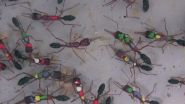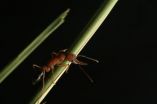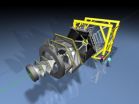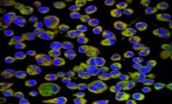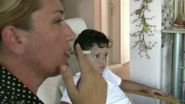(Press-News.org) VIDEO:
When an H. saltator colony's queen dies, the female workers engage in ritual fights to establish dominance. Ultimately, a small group of workers establishes dominance and become a cadre of...
Click here for more information.
The ritualized fighting behavior of one ant species is linked to increases in dopamine levels that trigger dramatic physical changes in the ants without affecting their DNA, according to research from North Carolina State University, Arizona State University and the U.S. Department of Agriculture.
The researchers studied Indian jumping ants (Harpegnathos saltator), which can undergo significant changes in physiology without any related changes to their DNA. Instead, the changes depend on which genes are turned on or off – which in turn is determined by social and environmental factors. This has made them a model organism for epigenetics researchers.
When an H. saltator colony's queen dies, the female workers engage in ritual fights to establish dominance. While these battles can be fierce, they rarely result in physical injury to the workers. Ultimately, a group of approximately 12 workers will establish dominance and become a cadre of worker queens or "gamergates." Video of the ritualized fighting behavior can be seen at https://www.youtube.com/watch?v=74ruqyOUX-8.
The gamergates look like ordinary workers, but undergo extreme internal changes: their brains shrink by 25 percent; their ovaries expand to fill their abdomens; and their life expectancy jumps from about six months to several years or more.
"We wanted to know what's responsible for these physical changes," says Dr. Clint Penick, lead author of a paper describing the work and a postdoctoral researcher at NC State. "The answer appears to be dopamine. We found that gamergates have dopamine levels two to three times higher than other workers."
To understand what was happening, the researchers took a subset of workers from a colony (Colony A) and separated them from their gamergates. These workers effectively formed their own colony (Colony B) and began fighting to establish dominance.
When some of the workers in Colony B began to get the upper hand, Penick removed them from the colony. He found that these dominant ants had already begun to produce elevated levels of dopamine – more than other workers, but still less than full-fledged gamergates.
Penick then placed these dominant workers back into Colony A. The regular Colony A workers recognized the changes in the dominant workers and exhibited "policing" behavior, holding down the dominant ants so that they couldn't move. Within 24 hours, the dopamine levels in the dominant workers had dropped back to normal; they were just regular worker ants again.
"This tells us that the very act of winning these ritual battles increases dopamine levels in H. saltator, which ultimately leads to the physical changes we see in gamergates," Penick says. "Similarly, losing these fights pushes dopamine levels down."
The findings may offer insight into the behavior of a range of social insect species, Penick says. "Policing behavior occurs in wasps and other ant species, and this study shows just how that behavior can regulate hormone levels to affect physiology and ensure that workers don't reproduce," he explains.
INFORMATION:
The paper, "Neurohormonal changes associated with ritualized combat and the formation of a reproductive hierarchy in the ant Harpegnathos saltator," is published in the May issue of The Journal of Experimental Biology. Senior author of the paper is Dr. Jürgen Liebig of Arizona State. The paper was co-authored by Dr. Colin Brent of the USDA and Kelly Dolezal of Arizona State.
Dopamine turns worker ants into warrior queens
2014-05-12
ELSE PRESS RELEASES FROM THIS DATE:
Major breakthrough in understanding Prader-Willi Syndrome, a parental imprinting disorder
2014-05-12
Scientists at the Hebrew University of Jerusalem have reported a major breakthrough in understanding the molecular basis for Prader-Willi syndrome (PWS), perhaps the most studied among the class of diseases that involves defects in parental imprinting.
The work, described in the latest online edition of the prestigious journal Nature Genetics, was led by Prof. Nissim Benvenisty, the Herbert Cohn Professor of Cancer Research and director of the Stem Cell Unit at the Alexander Silberman Institute of Life Sciences at the Hebrew University; and his PhD student Yonatan Stelzer. ...
Hijacking bacteria's natural defenses to trap and reveal pathogens
2014-05-12
The breakthrough, published in the journal Nature Materials, could offer an easier way of detecting pathogenic bacteria outside of a clinical setting and could be particularly important for the developing world, where access to more sophisticated laboratory techniques is often limited.
The research was led by Professor Cameron Alexander, Head of the Division of Drug Delivery and Tissue Engineering and EPSRC Leadership Fellow in the University's School of Pharmacy, building on work by PhD student Peter Magennis. Professor Alexander said: "Essentially, we have hijacked ...
Revealed:Protein's role in preventing heart muscle growth leading to heart failure
2014-05-12
Cardiovascular disease remains the number one cause of death in the Western world, with heart failure representing the fastest-growing subclass over the past decade. The stage that precedes heart failure in a significant number of cardiovascular diseases is pathological hypertrophy — the growth of the heart muscle in an attempt to increase its output.
Not all hypertrophy is pathological; for example, during pregnancy or high physical exertion, the muscle of the heart grows but myocardial function remains normal. But when hypertrophy is excessive, prolonged and unbalanced, ...
Link found between cell death and inflammatory disease
2014-05-12
A team of Melbourne researchers has shown a recently discovered type of cell death called necroptosis could be the underlying cause of inflammatory disease.
The research team discovered that a previously identified molecule involved in necroptosis, called RIPK1, was essential for survival by preventing uncontrolled inflammation. This finding could lead to future treatments for inflammatory diseases including Crohn's disease, rheumatoid arthritis and psoriasis.
The researchers, from the Walter and Eliza Hall Institute, also discovered that the 'survival' molecule RIPK1 ...
HADES searches for dark matter
2014-05-12
Although Dark Energy and Dark Matter appear to constitute over 95 percent of the universe, nobody knows of which particles they are made up. Astrophysicists now crossed one potential Dark Matter candidate – the Dark Photon or U boson – off the list in top position. This is the result of recent HADES experiments, where researchers from the Helmholtz-Zentrum Dresden-Rossendorf (HZDR) and from 17 other European institutes try to pin down the nature of Dark Matter. These negative results – recently published in Physics Letters B – could even lead to challenges of the Standard ...
Artificial magnetic bacteria 'turn' food into natural drugs
2014-05-12
Scientists from the University of Granada have successfully created magnetic bacteria that could be added to foodstuffs and could, after ingestion, help diagnose diseases of the digestive system like stomach cancer. These important findings constitute the first use of a food as a natural drug and aid in diagnosing an illness, anywhere in the world.
The researchers—members of Bionanomet, the Metallic Bionanoparticle research group of the Department of Inorganic Chemistry and the Institute of Biotechnology of the University of Granada—have conducted this research in collaboration ...
Recombinant adenovirus-mediated 3β-hydroxysteroid-Δ24 reductase inhibits neural apoptosis
2014-05-12
3β-Hydroxysteroid-Δ24 reductase (DHCR24) is a multifunctional enzyme that localizes to the endoplasmic reticulum and has neuroprotective and cholesterol-synthesizing activities. DHCR24 overexpression confers neuroprotection against apoptosis caused by amyloid β deposition. Dr. Xiuli Lu and colleagues from Liaoning University in China constructed two recombinant adenoviruses (Ad-rSYN1-DHCR24-myc and Ad-hSYN1-DHCR24-
myc) that drive DHCR24 expression specifically in neuronal cells. They also found that adenovirus transfection inhibits apoptosis through scavenging ...
Endocrine disruptors impair human sperm function
2014-05-12
HEIDELBERG, 12 May 2014 – A plethora of endocrine-disrupting chemicals interfere with human sperm function in a way that may have a negative impact on fertilization. These are the findings of a German - Danish team of researchers from the Center of Advanced European Studies and Research in Bonn, Germany, and the University Department of Growth and Reproduction, Rigshospitalet, Copenhagen, Denmark. The work, which is published in EMBO reports, suggests that endocrine disruptors may contribute to widespread fertility problems in the Western world in a way that hitherto has ...
Ultra-fast, the bionic arm can catch objects on the fly
2014-05-12
With its palm open, the robot is completely motionless. A split second later, it suddenly unwinds and catches all sorts of flying objects thrown in its direction -a tennis racket, a ball, a bottle-. This arm measures about 1.5 meters long and keeps an upright position. It has three joints and a sophisticated hand with four fingers. It was programmed at the Learning Algorithms and Systems Laboratory at EPFL (LASA) and designed to test robotic solutions for capturing moving objects. It is unique, as it has the ability to catch projectiles of various irregular shapes in less ...
Children of nicotine-addicted parents more likely to become heavy smokers
2014-05-12
VIDEO:
The more time a child is exposed to a parent addicted to smoking, the more likely the youth will not only take up cigarettes but also become a heavy smoker,...
Click here for more information.
WASHINGTON -- The more time a child is exposed to a parent addicted to smoking, the more likely the youth will not only take up cigarettes but also become a heavy smoker.
So warns a team of researchers led by Georgetown Lombardi Comprehensive Cancer Center scientists in Pediatrics. ...
